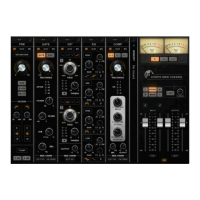Scheps Omni Channel / User Guide
Working with M/S
M/S mode can be tricky if you’re new to it. Below are some general guidelines that can help get you started thinking
in M/S for each module.
Using the Pre module in the M/S mode
You’re working with the stereo overheads track and you want to add a bit of separation and “attitude” to the kick and
snare that are on the O/H track. Choose M/S audio format. Open the Expanded view and add Clip to the Mid part of
the signal only until you find the right amount of crunch that comes with a clipped signal. This will certainly draw
attention to the kick and snare.
Try adding some Even harmonics to the side. This may defocus the edges a bit.
Using the EQ module in the M/S mode
EQ processing a mid/side signal is a classic way to open up a track and make space for an instrument that’s at the
center of a stereo image. You can use M/S EQ processing to help focus and separate the bass drum and snare from
the overheads. You will have pretty good control of the mono tracks, but add the stereo overhead and the mix can
become mushy, since the bass and snare are less focused in the O/H. To reconcile these two types of tracks, set
the EQ module audio format to M/S for the O/H, and then brighten up the sides and pull back the mid.
You can also think of it as helping an instrument work with the rest of the tracks. On a piano, adding low mids and
some focused upper mids can make it sound more powerful and have more tone. But this can fight with the bass and
vocal. Try adding these frequencies just to the sides and actually dialing back the low end in the middle. This will
leave more room for bass and vocals in the middle while still giving you a present, powerful piano.

